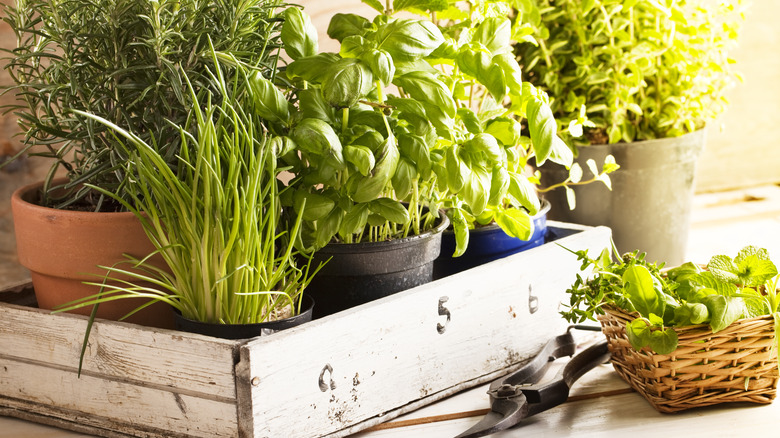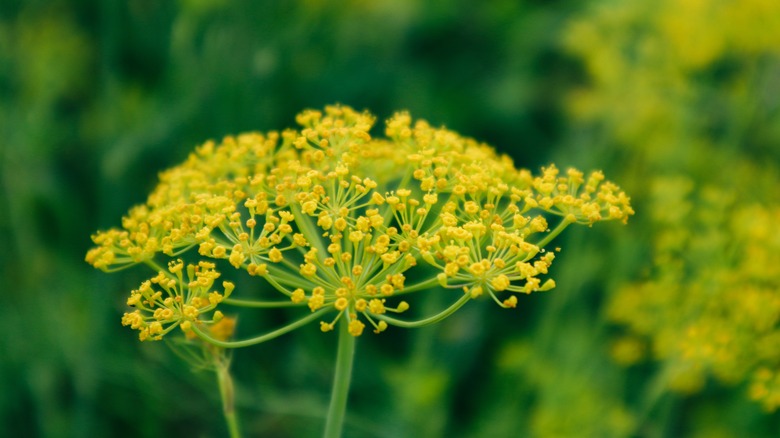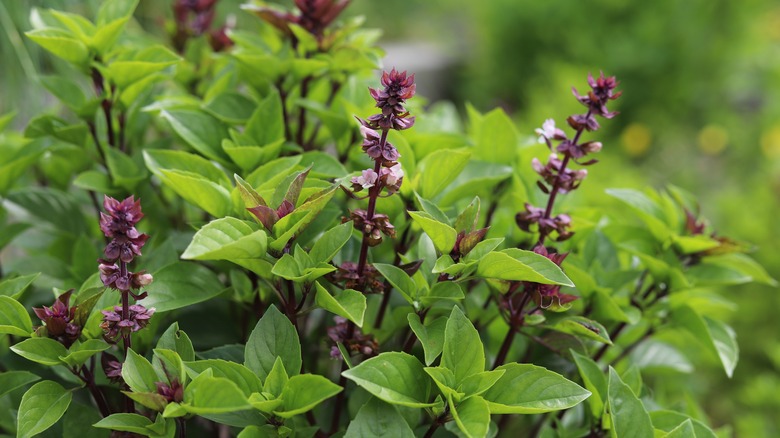Are The Flowers That Grow From Herbs Edible?
If you're a gardener (or, at the very least, desperately trying to keep that one grocery store basil plant alive on your windowsill), you've probably been taught to fear the flowers that grow on your culinary herbs. The common advice is that, to grow the tastiest basil, chives, or mint, you need to pinch any flower buds that may appear. Doing so will redirect the plant's energy back into its edible leaves.
But you don't have to toss those pesky flowers once you've pruned them off — you can eat them, too! Some of them, anyway. Many flowers that grow from herbs are edible, and taste similar to the herbs they come from. Basil, chives, cilantro, dill, mint, rosemary, and sage are just a few examples where their flowers can dress up a salad, elevate a bowl of pasta, or prettify a cake for a beautiful and tasty finishing touch that is sure to wow.
Savory herb flowers can elevate bagels, pasta, and more
For more savory floral applications, turn to herbs like dill, chives, and cilantro. Chives produce fluffy purple flowers that resemble clover, and taste mildly like chives. Dill produces wide clusters of tiny yellow flowers that have a dill flavor that actually overpowers the delicate fronds. Cilantro, similarly, produces small white flowers that are surprisingly pungent. All of these can be used in the same applications where you would use the herbs themselves.
For example, an amazing chewy bagel with lox and schmear, dotted with dill flowers, would be a gorgeous weekend brunch dish. Or, perhaps you'd rather wake up to a quiche or omelet finished with beautiful chive blossoms. For dinner, think about crunching into a delicious fish taco or a bowl of pad Thai, dressed up with some sprigs of cilantro flowers.
Where chives are concerned, you can actually look to the entire allium family for edible flowers. Though other alliums like onions, garlic, and shallots are not typically considered to be herbs, they all produce edible flowers. Just be sure to steer clear of plants labeled as ornamental alliums, which may be treated with pesticides.
Edible flowers can make sweet treats better, too
If you want to use edible flowers in sweet applications, you should look to herbs such as mint, rosemary, Thai or sweet basil, and sage. Rosemary and basil flowers actually taste slightly minty — almost licorice-like, in the case of basil. This is because sage, rosemary, and all basil varieties are actually in the mint family, Lamiaceae. Lavender, whose flower buds are more commonly used in cooking, is also a member of this family, as are thyme, oregano, and marjoram. All produce edible flowers that taste like sweeter, milder iterations of their leaves.
Thyme flowers can also be used to make a sweet liqueur similar to the traditional Farigoule digestif from the South of France. Oregano flowers are another wonder. As a seasoning, it's great on pizza and other Italian dishes, but the flowers can also be brewed into a soothing tea to treat sore throats.
Flowers from rosemary, basil, sage, or mint can be used similarly, as a topping on baked goods like cakes or citrus tarts, or mixed into a beautiful fruit salad. They're also great to infuse in honey, or to make a fragrant simple syrup, as a way to preserve their fleeting flavor. As always, what grows together, goes together, so have fun exploring the different flavor combinations you can achieve by pairing herb flowers with fresh, seasonal produce.



